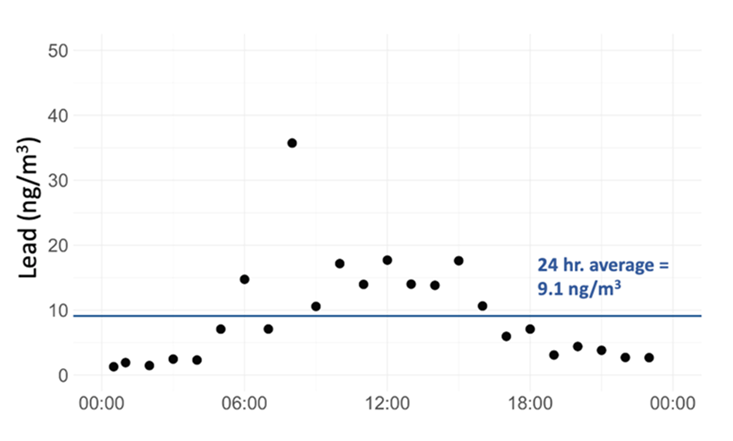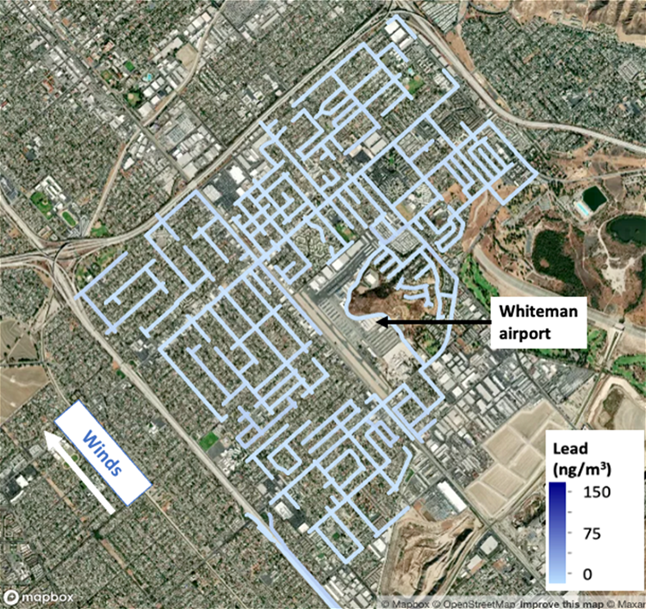Background
Whiteman airport is a general aviation airport in the northeastern San Fernando Valley community of Pacoima, CA. The airport is open to general aviation aircraft 24-hours a day, seven days a week, and is home to over 600 aircrafts and numerous aviation-related businesses. Aircraft with piston-driven engines typically use aviation gasoline (avgas), which is the only transportation fuel in the United States that contains lead. This has caused concerns about potential exposure to increased lead concentrations for people living near small airports such as Whiteman. The Federal Aviation Administration (FAA) is working to develop a strategy to reduce and ultimately eliminate lead from avgas by 2030.
As part of the most recent Multiple Air Toxics Exposure Study (MATES V), South Coast AQMD conducted air measurements of several air toxic contaminants at Whiteman airport between 2018 and 2019 and found that ambient lead levels ranged from 0.4 ng/m3 to 19.7 ng/m3 with an average study value of 6.9 ng/m3. This is substantially lower than the U.S. EPA Lead National Ambient Air Quality Standard (NAAQS) of 150 ng/m3 (which is reported as a rolling 3-month average) and similar to lead concentrations found in other parts of the South Coast Air Basin during the same time period. South Coast AQMD conducted additional air measurement efforts at and around Whiteman airport between July and September 2022 to further characterize ambient lead levels in this area.
24-Hour Air Sampling and Results
Between July 10 and September 2, 2022, ten 24-hour samples were collected at Whiteman airport on Airpark Way, about 700 feet northeast of the runway (Figure 1) and analyzed for lead at South Coast AQMD’s laboratory.

Figure 1. Sampling location at Whiteman airport for time-integrated and continuous stationary monitoring with the high-volume sampler (A) and mobile monitoring platform (B).
The 24-hour results at Whiteman airport showed lead levels between 8 and 17 ng/m3 with an average ambient concentration of 12.1 ng/m3, which is substantially lower than U.S. EPA’s national standard (150 ng/m3). These levels were also within the typical range of concentrations measured Basin-wide as part of MATES V (Figure 2).

Figure 2. Time-integrated lead measurements taken at Whiteman airport between July 10 and September 2, 2022. The shaded region shows the range for lead measured during MATES V (Basin-wide, up to the 99th percentile). The dotted line shows the U.S. EPA National Ambient Air Quality Standard (NAAQS) for lead (150 ng/m3), which is reported as a rolling 3-month average.
Continuous Stationary Measurements
On July 28, 2022, hourly lead measurements were taken with a continuous metals monitor at a fixed location on Airpark Way (see Figure 1). With the exception of one sample of 35.7 ng/m3 in the mid-morning, all lead levels ranged between 1.3 ng/m3 and 17.7 ng/m3 with an average daily value of 9.1 ng/m3 (Figure 3), comparable to the 24-hr time-integrated measurements. Concentrations on this day were higher during the mid-day and lower during the early morning and late evening.

Figure 3. Continuous stationary lead measurements at Whiteman airport taken on July 28, 2022.
Mobile Monitoring
South Coast AQMD developed and used a new mobile monitoring platform that can detect multiple air toxic metals (including lead) with a high time resolution. This platform is an effective screening tool that was used to verify the potential presence of any metal hotspots in the community. While each time-integrated measurement collected at the airport represents an average lead concentration over a 24-hour period at one location, lead levels measured with the mobile platform were all taken in quick 5-minute time frames in areas near the airport. The map in Figure 4 summarizes the results of the mobile survey taken around the airport and in the surrounding communities on September 27, 2022. Ambient lead levels were less than 15 ng/m3, with the highest value measured on the 5 highway near other potential sources of lead. The results of the mobile survey showed lead levels to be within or below the range observed from the stationary measurements taken at Whiteman between July 10 and September 2, 2022, and substantially below U.S. EPA’s standard (150 ng/m3).

Figure 4. Map showing the results of the mobile monitoring survey conducted on September 27, 2022 around Whiteman airport.
Summary
Between July and September 2022, South Coast AQMD conducted a short study to better understand lead levels at Whiteman airport and in the surrounding communities using a variety of different monitoring techniques including 24-hour samples, continuous sampling, and mobile monitoring. While piston-driven aircraft can be sources of lead, South Coast AQMD’s study showed lead to be within the typical range measured during MATES V and more than 10 times lower than the U.S. EPA national standard for lead.